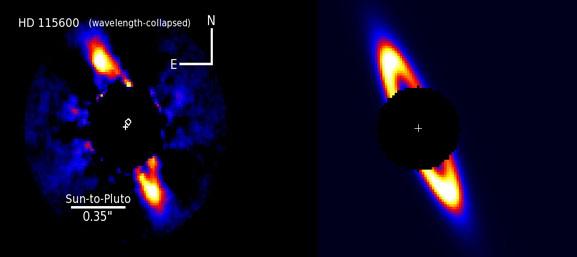
An international team of astronomers, including researchers from the University of Cambridge, has identified a young planetary system which may aid in understanding how our own solar system formed and developed billions of years ago.
Using the Gemini Planet Imager (GPI) at the Gemini South telescope in Chile, the researchers identified a disc-shaped bright ring of dust around a star only slightly more massive than the sun, located 360 light years away in the Centaurus constellation. The disc is located between about 37 and 55 Astronomical Units (3.4 – 5.1 billion miles) from its host star, which is almost the same distance as the solar system’s Kuiper Belt is from the sun. The brightness of the disc, which is due to the starlight reflected by it, is also consistent with a wide range of dust compositions including the silicates and ice present in the Kuiper Belt.
The Kuiper Belt lies just beyond Neptune, and contains thousands of small icy bodies left over from the formation of the solar system more than four billion years ago. These objects range in size from specks of debris dust, all the way up to moon-sized objects like Pluto – which used to be classified as a planet, but has now been reclassified as a dwarf planet.
The star observed in this new study is a member of the massive 10-20 million year-old Scorpius-Centaurus OB association, a region similar to that in which the sun was formed. The disc is not perfectly centred on the star, which is strong indication that it was likely sculpted by one or more unseen planets. By using models of how planets shape a debris disc, the team found that ‘eccentric’ versions of the giant planets in the outer solar system could explain the observed properties of the ring.
“It’s almost like looking at the outer solar system when it was a toddler,” said principal investigator Thayne Currie, an astronomer at the Subaru Observatory in Hawaii.
The current theory on the formation of the solar system holds that it originated within a giant molecular cloud of hydrogen, in which clumps of denser material formed. One of these clumps, rotating and collapsing under its own gravitation, formed a flattened spinning disc known as the solar nebula. The sun formed at the hot and dense centre of this disc, while the planets grew by accretion in the cooler outer regions. The Kuiper Belt is believed to be made up of the remnants of this process, so there is a possibility that once the new system develops, it may look remarkably similar to our solar system.
“To be able to directly image planetary birth environments around other stars at orbital distances comparable to the solar system is a major advancement,” said Dr Nikku Madhusudhan of Cambridge’s Institute of Astronomy, one of the paper’s co-authors. “Our discovery of a near-twin of the Kuiper Belt provides direct evidence that the planetary birth environment of the solar system may not be uncommon.”
This is the first discovery with the new cutting-edge Gemini instrument. “In just one of our many 50-second exposures we could see what previous instruments failed to see in more than 50 minutes,” said Currie.
The star, going by the designation HD 115600, was the first object the research team looked at. “Over the next few years, I’m optimistic that GPI will reveal many more debris discs and young planets. Who knows what strange, new worlds we will find,” Currie added.
The paper is accepted for publication in The Astrophysical Journal Letters.
Astronomers have discovered a disc of planetary debris surrounding a young sun-like star that shares remarkable similarities with the Kuiper Belt that lies beyond Neptune, and may aid in understanding how our solar system developed.

The text in this work is licensed under a Creative Commons Attribution 4.0 International License. For image use please see separate credits above.